Self-Centering Shape Memory Alloy-Viscoelastic Hybrid Braces for Seismic Resilience
Abstract
:1. Introduction
2. Configuration and Working Principle of SCVEB
2.1. SC System
2.2. ED System
2.3. Theoretical Activation Force of SCVEB
3. Investigation on Kernel Elements
3.1. Individual SMA Cable Test
3.2. Viscoelastic Material Test
4. Experimental Verification of Proposed SCVEB
4.1. Information of SCVEB Specimen
4.2. Test Setup, Instrumentation, and Loading Protocol
4.3. Test Results and Discussions
5. System-Level Analysis
5.1. Prototype Buildings
5.2. Design and Modeling
5.2.1. Conventional Buckling Restrained Brace Frame (BRBF)
5.2.2. Typical Self-Centering SMA Cable-Based Frame (SCBF)
5.2.3. Frame with SCVEB (SCVEBF)
5.3. Structural Performance
5.3.1. Peak Inter-Story Drift (PID)
5.3.2. Residual Inter-Story Drift (RID)
5.3.3. Absolute Peak Floor Acceleration (PFA)
6. Conclusions
Author Contributions
Funding
Institutional Review Board Statement
Informed Consent Statement
Data Availability Statement
Acknowledgments
Conflicts of Interest
References
- Matsuyama, M.; Kimura, R.; Hayashi, H. Organizational Structure and Institutions for Disaster Prevention: Research on the 1995 Great Hanshin-Awaji Earthquake in Kobe City. J. Disaster Res. 2015, 10, 1051–1066. [Google Scholar] [CrossRef]
- Nguyen, V.Q.; Nizamani, Z.A.; Park, D.; Kwon, O.S. Numerical simulation of damage evolution of Daikai station during the 1995 Kobe earthquake. Eng. Struct. 2020, 206, 110180. [Google Scholar] [CrossRef]
- Luo, Q.B.; Dai, F.; Liu, Y.; Gao, M.T. Numerical modelling of the near-field velocity pulse-like ground motions of the Northridge earthquake. Acta Geophys. 2020, 68, 993–1006. [Google Scholar] [CrossRef]
- Bruneau, M.; MacRae, G. Building Structural Systems in Christchurch’s Post-Earthquake Reconstruction. Earthq. Spectra 2019, 35, 1953–1978. [Google Scholar] [CrossRef]
- McCormick, J.; Aburano, H.; Ikenaga, M.; Nakashima, M. Permissible residual deformation levels for building structures considering both safety and human elements. In Proceedings of the 14th World Conference on Earthquake Engineering, Beijing, China, 12 October 2008; Seismological Press of China: Beijing, China, 2008. [Google Scholar]
- Chou, C.C.; Chung, P.T.; Cheng, Y.T. Experimental evaluation of large-scale dual-core self-centering braces and sandwiched buckling-restrained braces. Eng. Struct. 2016, 116, 12–25. [Google Scholar] [CrossRef]
- Fang, C.; Wang, W.; Qiu, C.; Hu, S.; Macrae, G.A.; Eatherton, M.R. Seismic resilient steel structures: A review of research, practice, challenges and opportunities. J. Constr. Steel Res. 2022, 191, 107172. [Google Scholar] [CrossRef]
- Lin, Y.C.; Ricles, J.M.; Sause, R. Seismic performance of a steel Self-Centering Moment Resisting Frame: Hybrid simulations under DBE and MCE. In Stessa 2012: Proceedings of the 7th International Conference on Behaviour of Steel Structures in Seismic Areas, Santiago, Chile, 9–11 January 2012; CRC Press: Boca Raton, FL, USA, 2012; pp. 729–735. [Google Scholar]
- Lin, Y.C.; Sause, R.; Ricles, J. Seismic Performance of a Large-Scale Steel Self-Centering Moment-Resisting Frame: MCE Hybrid Simulations and Quasi-Static Pushover Tests. J. Struct. Eng. 2013, 139, 1227–1236. [Google Scholar] [CrossRef]
- Li, Z.; He, M.J.; Wang, K.L. Hysteretic Performance of Self-Centering Glulam Beam-to-Column Connections. J. Struct. Eng. 2018, 144, 04018031. [Google Scholar] [CrossRef]
- Yun, C.; Chao, C.; Cong, C. Study on seismic performance of prefabricated self-centering beam to column rotation friction energy dissipation connection. Eng. Struct. 2021, 241, 112136. [Google Scholar] [CrossRef]
- Huang, L.J.; Zhou, Z.; Liu, H.; Si, Y. Experimental Investigation of Hysteretic Performance of Self-Centering Glulam Beam-to-Column Joint with Friction Dampers. J. Earthq. Tsunami 2021, 15, 2150005. [Google Scholar] [CrossRef]
- Cai, X.N.; Pan, Z.F.; Zhu, Y.Z.; Gong, N.N.; Wang, Y.W. Experimental and numerical investigations of self-centering post-tensioned precast beam-to-column connections with steel top and seat angles. Eng. Struct. 2021, 226, 111397. [Google Scholar] [CrossRef]
- Huang, L.J.; Zhou, Z.; Peng, Z.; Ma, J.F. Experimental investigation of a self-centering precast concrete beam-to-column connection with top and bottom friction energy dissipaters. Struct. Des. Tall Spec. Build. 2020, 29, e1707. [Google Scholar] [CrossRef]
- Deng, K.L.; Pan, P.; Lam, A.; Pan, Z.H.; Ye, L.P. Test and simulation of full-scale self-centering beam-to-column connection. Earthq. Eng. Eng. Vib. 2013, 12, 599–607. [Google Scholar] [CrossRef]
- Ergang, X.; Kun, Z.; Jing, W. Seismic performanceanalysis of self-centering concentrically braced steel frame structures. World Earthq. Eng. 2020, 36, 69–79. [Google Scholar]
- Fang, C.; Wang, W.; He, C.; Chen, Y. Self-centring behaviour of steel and steel-concrete composite connections equipped with NiTi SMA bolts. Eng. Struct. 2017, 150, 390–408. [Google Scholar] [CrossRef]
- Christopoulos, C.; Tremblay, R.; Kim, H.-J.; Lacerte, M. Self-centering energy dissipative bracing system for the seismic resistance of structures: Development and validation. J. Struct. Eng. 2008, 134, 96–107. [Google Scholar] [CrossRef]
- Chou, C.C.; Chung, P.T. Development of cross-anchored dual-core self-centering braces for seismic resistance. J. Constr. Steel Res. 2014, 101, 19–32. [Google Scholar] [CrossRef]
- Zhou, Z.; Xie, Q.; Lei, X.C.; He, X.T.; Meng, S.P. Experimental Investigation of the Hysteretic Performance of Dual-Tube Self-Centering Buckling-Restrained Braces with Composite Tendons. J. Compos. Constr. 2015, 19, 04015011. [Google Scholar] [CrossRef]
- Xu, L.H.; Xie, X.S.; Li, Z.X. Seismic Behavior and Design Approach of Variable-Damping Self-Centering Braced Frame. J. Struct. Eng. 2021, 147, 05021001. [Google Scholar] [CrossRef]
- Xiao, Y.; Eberhard, M.O.; Zhou, Y.; Stanton, J.F. Proportioning of self-centering energy dissipative braces. Earthq. Eng. Struct. Dyn. 2021, 50, 2613–2633. [Google Scholar] [CrossRef]
- Sun, G.H.; Zhu, Y. Cyclic testing of an innovative self-centering X-braced ductile shear panel. Eng. Struct. 2021, 244, 112732. [Google Scholar] [CrossRef]
- Rezvan, P.; Zhang, Y.F. Nonlinear seismic performance study of D-type self-centering eccentric braced frames with sliding rocking link beams. Earthq. Eng. Struct. Dyn. 2021, 51, 875–895. [Google Scholar] [CrossRef]
- O’Reilly, G.J.; Goggins, J. Experimental testing of a self-centring concentrically braced steel frame. Eng. Struct. 2021, 238, 111521. [Google Scholar] [CrossRef]
- Chung, P.T.; Chou, C.C.; Ling, Y.T. Mechanics, modeling and seismic behavior of a dual-core self-centering brace in series with a frictional gusset connection. Eng. Struct. 2021, 247, 113018. [Google Scholar] [CrossRef]
- Chou, C.C.; Tsai, W.J.; Chung, P.T. Development and validation tests of a dual-core self-centering sandwiched buckling-restrained brace (SC-SBRB) for seismic resistance. Eng. Struct. 2016, 121, 30–41. [Google Scholar] [CrossRef]
- Kitayama, S.; Constantinou, M.C. Probabilistic collapse resistance and residual drift assessment of buildings with fluidic self-centering systems. Earthq. Eng. Struct. Dyn. 2016, 45, 1935–1953. [Google Scholar] [CrossRef]
- Wang, W.; Fang, C.; Zhao, Y.; Sause, R.; Hu, S.; Ricles, J. Self-centering friction spring dampers for seismic resilience. Earthq. Eng. Struct. Dyn. 2019, 48, 1045–1065. [Google Scholar] [CrossRef]
- Wang, Y.W.; Zhou, Z.; Zhang, L.X.; Zhao, K.S. Hysteretic Behavior of Dual-Self-Centering Variable Friction Damper Braces with Low Pretensioned Force. J. Earthq. Eng. 2021, 1997840. [Google Scholar] [CrossRef]
- Wang, Y.W.; Zhou, Z.; Zhang, L.X.; Xie, Q. Quantification of higher mode effects of steel frame and control method using dual self-centering variable friction damper brace. Eng. Struct. 2021, 240, 112368. [Google Scholar] [CrossRef]
- Wang, Y.W.; Zeng, B.; Zhou, Z.; Xie, Q. Hysteretic and seismic performance of dual self-centering variable friction damper braces. Soil Dyn. Earthq. Eng. 2021, 147, 106774. [Google Scholar] [CrossRef]
- Veismoradi, S.; Yousef-beik, S.M.M.; Zarnani, P.; Quenneville, P. Development and parametric study of a new self-centering rotational friction damper. Eng. Struct. 2021, 235, 112097. [Google Scholar] [CrossRef]
- Qiu, C.X.; Liu, J.W.; Du, X.L. Analytical and numerical study on the cyclic behavior of buckling-restrained SMA-based self-centering damper. Smart Mater. Struct. 2021, 30, 095021. [Google Scholar] [CrossRef]
- Falahian, A.; Asadi, P.; Riahi, H.T.; Kadkhodaei, M. An experimental study on a self-centering damper based on shape-memory alloy wires. Mech. Based Des. Struct. Mach. 2021, 1939048. [Google Scholar] [CrossRef]
- Ding, Y.; Zhou, Z.; Huang, L.J.; Si, Y. Seismic performance of self-centering glulam frame with friction damper. Eng. Struct. 2021, 245, 112857. [Google Scholar] [CrossRef]
- Zhu, R.Z.; Guo, T.; Mwangilwa, F. Development and test of a self-centering fluidic viscous damper. Adv. Struct. Eng. 2020, 23, 2835–2849. [Google Scholar] [CrossRef]
- Zhu, S.Y.; Zhang, Y.F. Seismic analysis of concentrically braced frame systems with self-centering friction damping braces. J. Struct. Eng. 2008, 134, 121–131. [Google Scholar] [CrossRef]
- Kam, W.Y.; Pampanin, S.; Palermo, A.; Carr, A. Advanced Flag-Shaped Systems For High Seismic Performance. In Proceedings of the First European Conference on Earthquake Engineering and Seismology, Geneva, Switzerland, 3–8 September 2006. [Google Scholar]
- Shi, Y.; Xinxin, J.; Changhong, D. Mechanical performances of a new type of resilient SMA damper. World Earthq. Eng. 2020, 36, 96–102. [Google Scholar]
- Zhang, R.B.; Wang, W.; Fang, C.; Zhang, W.J.; Zhuang, L.J. Self-centering Devices with Paralleled Friction Spring Groups: Development, Experiment and System Behavior. J. Earthq. Eng. 2021, 2009059. [Google Scholar] [CrossRef]
- Ricles, J.M.; Sause, R.; Peng, S.W.; Lu, L.W. Experimental evaluation of earthquake resistant posttensioned steel connections. J. Struct. Eng. 2002, 128, 850–859. [Google Scholar] [CrossRef]
- Garlock, M.M.; Sause, R.; Ricles, J.M. Behavior and design of posttensioned steel frame systems. J. Struct. Eng. 2007, 133, 389–399. [Google Scholar] [CrossRef]
- Maurya, A.; Eatherton, M.R. Experimental study of the restoring force mechanism in the self-centering beam (SCB). Front. Struct. Civ. Eng. 2016, 10, 272–282. [Google Scholar] [CrossRef]
- Fang, C.; Zhong, Q.M.; Wang, W.; Hu, S.L.; Qiu, C.X. Peak and residual responses of steel moment-resisting and braced frames under pulse-like near-fault earthquakes. Eng. Struct. 2018, 177, 579–597. [Google Scholar] [CrossRef]
- Fan, X.W.; Xu, L.H.; Li, Z.X. Seismic performance evaluation of steel frames with pre-pressed spring self-centering braces. J. Constr. Steel Res. 2019, 162, 105761. [Google Scholar] [CrossRef]
- Zhang, Z.-X.; Zhang, J.; Wu, H.; Ji, Y.; Kumar, D.D. Iron-Based Shape Memory Alloys in Construction: Research, Applications and Opportunities. Materials 2022, 15, 1723. [Google Scholar] [CrossRef] [PubMed]
- Fang, C.; Yam, M.C.H.; Lam, A.C.C.; Xie, L. Cyclic performance of extended end-plate connections equipped with shape memory alloy bolts. J. Constr. Steel Res. 2014, 94, 122–136. [Google Scholar] [CrossRef]
- Yam, M.C.H.; Fang, C.; Lam, A.C.C.; Zhang, Y. Numerical study and practical design of beam-to-column connections with shape memory alloys. J. Constr. Steel Res. 2015, 104, 177–192. [Google Scholar] [CrossRef]
- Fang, C.; Zhou, X.; Osofero, A.I.; Shu, Z.; Corradi, M. Superelastic SMA Belleville washers for seismic resisting applications: Experimental study and modelling strategy. Smart Mater. Struct. 2016, 25, 105013. [Google Scholar] [CrossRef] [Green Version]
- Villa, E. Manufacturing of Shape Memory Alloys. In Shape Memory Alloy Engineering; Elsevier: Amsterdam, The Netherlands, 2015; pp. 79–96. [Google Scholar]
- Fang, C.; Yam, M.C.H.; Chan, T.-M.; Wang, W.; Yang, X.; Lin, X. A study of hybrid self-centring connections equipped with shape memory alloy washers and bolts. Eng. Struct. 2018, 164, 155–168. [Google Scholar] [CrossRef]
- Fang, C.; Zheng, Y.; Chen, J.; Yam, M.C.H.; Wang, W. Superelastic NiTi SMA cables: Thermal-mechanical behavior, hysteretic modelling and seismic application. Eng. Struct. 2019, 183, 533–549. [Google Scholar] [CrossRef]
- Fang, C.; Yam, M.C.H.; Ma, H.; Chung, K.F. Tests on superelastic Ni–Ti SMA bars under cyclic tension and direct-shear: Towards practical recentring connections. Mater. Struct. 2013, 48, 1013–1030. [Google Scholar] [CrossRef]
- Zheng, Y.; Fang, C.; Liang, D.; Sun, R. An innovative seismic-resilient bridge with shape memory alloy-washer-based footing rocking RC piers. J. Intell. Mater. Syst. Struct. 2020, 32, 549–567. [Google Scholar] [CrossRef]
- Wang, W.; Fang, C.; Liu, J. Large size superelastic SMA bars: Heat treatment strategy, mechanical property and seismic application. Smart Mater. Struct. 2016, 25, 075001. [Google Scholar] [CrossRef]
- Fang, C.; Yam, M.C.H.; Lam, A.C.C.; Zhang, Y.Y. Feasibility study of shape memory alloy ring spring systems for self-centring seismic resisting devices. Smart Mater. Struct. 2015, 24, 075024. [Google Scholar] [CrossRef]
- Qiu, C.X.; Zhu, S.Y. Shake table test and numerical study of self-centering steel frame with SMA braces. Earthq. Eng. Struct. Dyn. 2017, 46, 117–137. [Google Scholar] [CrossRef]
- Miller, D.J.; Fahnestock, L.A.; Eatherton, M.R. Development and experimental validation of a nickel-titanium shape memory alloy self-centering buckling-restrained brace. Eng. Struct. 2012, 40, 288–298. [Google Scholar] [CrossRef]
- Chen, J.; Fang, C.; Wang, W.; Liu, Y. Variable-friction self-centering energy-dissipation braces (VF-SCEDBs) with NiTi SMA cables for seismic resilience. J. Constr. Steel Res. 2020, 175, 106318. [Google Scholar] [CrossRef]
- Fang, C.; Ping, Y.; Chen, Y.; Yam, M.C.H.; Chen, J.; Wang, W. Seismic Performance of Self-centering Steel Frames with SMA-viscoelastic Hybrid Braces. J. Earthq. Eng. 2020, 1856233. [Google Scholar] [CrossRef]
- Jha, N.K.; Dobriyal, R.; Kumar, P.; Badhotiya, G.K. On the modelling of nonlinear viscoelastic relation for rubber-like materials. Mater. Today-Proc. 2021, 46, 10546–10550. [Google Scholar] [CrossRef]
- Tsai, C.S.; Lee, H.H. Applications of Viscoelastic Dampers to High-Rise Buildings. J. Struct. Eng. 1993, 119, 1222–1233. [Google Scholar] [CrossRef]
- Shu, Z.; Gan, Z.Z.; Fang, C.; MacRae, G.; Dong, H.L.; Xie, Y.Z. Replaceable Rotational Viscoelastic Dampers for Improving Structural Damping and Resilience of Steel Frames. J. Earthq. Eng. 2021, 2009058. [Google Scholar] [CrossRef]
- Zhang, Z.; Liang, D.; Fang, C.; Zheng, Y. Experimental study and dynamic analysis on self-centering rocking piers equipped with shape memory alloy (SMA) cables. World Earthq. Eng. 2020, 36, 138–146. [Google Scholar]
- Fang, C.; Liang, D.; Zheng, Y.; Lu, S.Y. Seismic performance of bridges with novel SMA cable-restrained high damping rubber bearings against near-fault ground motions. Earthq. Eng. Struct. Dyn. 2022, 51, 44–65. [Google Scholar] [CrossRef]
- Wang, W.; Fang, C.; Shen, D.; Zhang, R.; Ding, J.; Wu, H. Performance assessment of disc spring-based self-centering braces for seismic hazard mitigation. Eng. Struct. 2021, 242, 112527. [Google Scholar] [CrossRef]
- Fang, C.; Wang, W.; Ricles, J.; Yang, X.; Zhong, Q.; Sause, R.; Chen, Y. Application of an Innovative SMA Ring Spring System for Self-Centering Steel Frames Subject to Seismic Conditions. J. Struct. Eng. 2018, 144, 0401811. [Google Scholar] [CrossRef]
- Fang, C.; Wang, W.; Zhang, A.; Sause, R.; Ricles, J.; Chen, Y. Behavior and Design of Self-Centering Energy Dissipative Devices Equipped with Superelastic SMA Ring Springs. J. Struct. Eng. 2019, 145, 04019109. [Google Scholar] [CrossRef]
- Feng, W.; Fang, C.; Wang, W. Behavior and design of top flange-rotated self-centering steel connections equipped with SMA ring spring dampers. J. Constr. Steel Res. 2019, 159, 315–329. [Google Scholar] [CrossRef]
- Wang, W.; Fang, C.; Zhang, A.; Liu, X. Manufacturing and performance of a novel self-centring damper with shape memory alloy ring springs for seismic resilience. Struct. Control. Health Monit. 2019, 26, e2337. [Google Scholar] [CrossRef]
- Fang, C.; Liang, D.; Zheng, Y.; Yam, M.C.H.; Sun, R. Rocking bridge piers equipped with shape memory alloy (SMA) washer springs. Eng. Struct. 2020, 214, 110651. [Google Scholar] [CrossRef]
- Liang, D.; Zheng, Y.; Fang, C.; Yam, M.C.H.; Zhang, C. Shape memory alloy (SMA)-cable-controlled sliding bearings: Development, testing, and system behavior. Smart Mater. Struct. 2020, 29, 085006. [Google Scholar] [CrossRef]
- Ping, Y.; Fang, C.; Chen, Y.; Yam, M.C.H. Seismic robustness of self-centering braced frames suffering tendon failure. Earthq. Eng. Struct. Dyn. 2021, 50, 1671–1691. [Google Scholar] [CrossRef]
- Qiu, C.; Fang, C.; Liang, D.; Du, X.; Yam, M.C.H. Behavior and application of self-centering dampers equipped with buckling-restrained SMA bars. Smart Mater. Struct. 2020, 29, 035009. [Google Scholar] [CrossRef]
- Liu, Y.; Wang, H.; Qiu, C.; Zhao, X. Seismic Behavior of Superelastic Shape Memory Alloy Spring in Base Isolation System of Multi-Story Steel Frame. Materials 2019, 12, 997. [Google Scholar] [CrossRef] [Green Version]
- Fang, C.; Ping, Y.; Zheng, Y.; Chen, Y. Probabilistic economic seismic loss estimation of steel braced frames incorporating emerging self-centering technologies. Eng. Struct. 2021, 241, 112486. [Google Scholar] [CrossRef]
- McKenna, F. OpenSees: A Framework for Earthquake Engineering Simulation. Comput. Sci. Eng. 2011, 13, 58–66. [Google Scholar] [CrossRef]
- Diani, J.; Fayolle, B.; Gilormini, P. A review on the Mullins effect. Eur. Polym. J. 2009, 45, 601–612. [Google Scholar] [CrossRef] [Green Version]
- Gong, S.M.; Zhou, Y.; Ge, P.L. Seismic analysis for tall and irregular temple buildings: A case study of strong nonlinear viscoelastic dampers. Struct. Des. Tall Spec. 2017, 26, e1352. [Google Scholar] [CrossRef]
- Zhou, Y.; Aguaguina, M.; Beskos, D.E.; Gong, S.M. A displacement-based seismic design method for building structures with nonlinear viscoelastic dampers. Bull. Earthq. Eng. 2021, 19, 4535–4585. [Google Scholar] [CrossRef]
- Ghosh, K.; Shrimali, B.; Kumar, A.; Lopez-Pamies, O. The nonlinear viscoelastic response of suspensions of rigid inclusions in rubber: I-Gaussian rubber with constant viscosity. J. Mech. Phys. Solids 2021, 154, 104544. [Google Scholar] [CrossRef]
- Vaiana, N.; Spizzuoco, M.; Serino, G. Wire rope isolators for seismically base-isolated lightweight structures: Experimental characterization and mathematical modeling. Eng. Struct. 2017, 140, 498–514. [Google Scholar] [CrossRef]
- Fang, C.; Ping, Y.; Chen, Y. Loading protocols for experimental seismic qualification of members in conventional and emerging steel frames. Earthq. Eng. Struct. Dyn. 2019, 49, 155–174. [Google Scholar] [CrossRef]
- ASCE. Minimum Design Loads for Buildings and Other Structures; American Society of Civil Engineers (ASCE): Reston, VA, USA, 2016. [Google Scholar]
- Zimmer, M.S. Characterization of Viscoelastic Materials for Use in Seismic Energy Dissipation Systems; State University of New York at Buffalo: Buffalo, NY, USA, 1999. [Google Scholar]
- Vaiana, N.; Sessa, S.; Marmo, F.; Rosati, L. A class of uniaxial phenomenological models for simulating hysteretic phenomena in rate-independent mechanical systems and materials. Nonlinear Dyn. 2018, 93, 1647–1669. [Google Scholar] [CrossRef]
- Vaiana, N.; Sessa, S.; Rosati, L. A generalized class of uniaxial rate-independent models for simulating asymmetric mechanical hysteresis phenomena. Mech. Syst. Signal. Process. 2021, 146, 106984. [Google Scholar] [CrossRef]
- FEMAP695. Quantification of Building Seismic Performance Factors; FEMAP695: Redwood City, CA, USA, 2009. [Google Scholar]
- Somerville, P.G. Magnitude scaling of the near fault rupture directivity pulse. Phys. Earth Planet. Inter. 2003, 137, 201–212. [Google Scholar] [CrossRef]
- Baker, J.W. Quantitative classification of near-fault ground motions using wavelet analysis. Bull. Seismol. Soc. Am. 2007, 97, 1486–1501. [Google Scholar] [CrossRef]
- Tremblay, R.; Lacerte, M.; Christopoulos, C. Seismic response of multistory buildings with self-centering energy dissipative steel braces. J. Struct. Eng. 2008, 134, 108–120. [Google Scholar] [CrossRef]


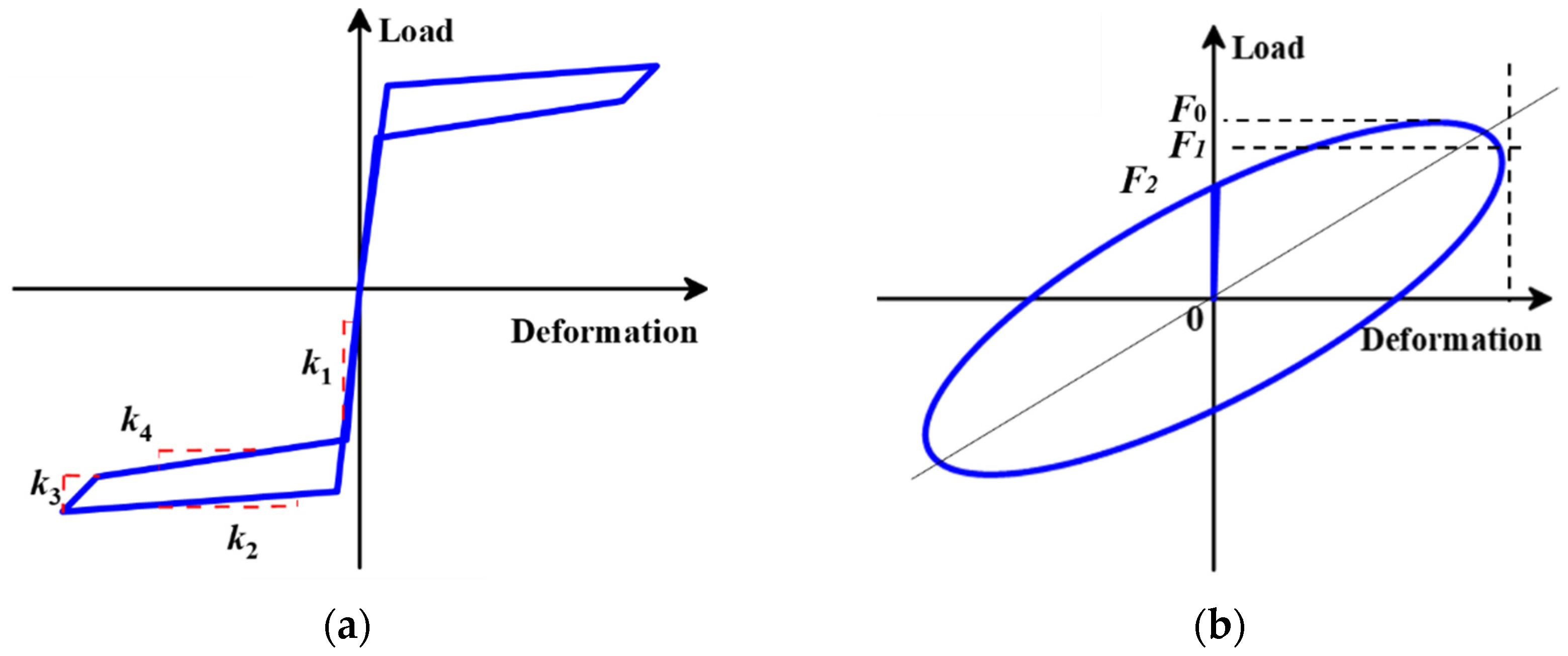

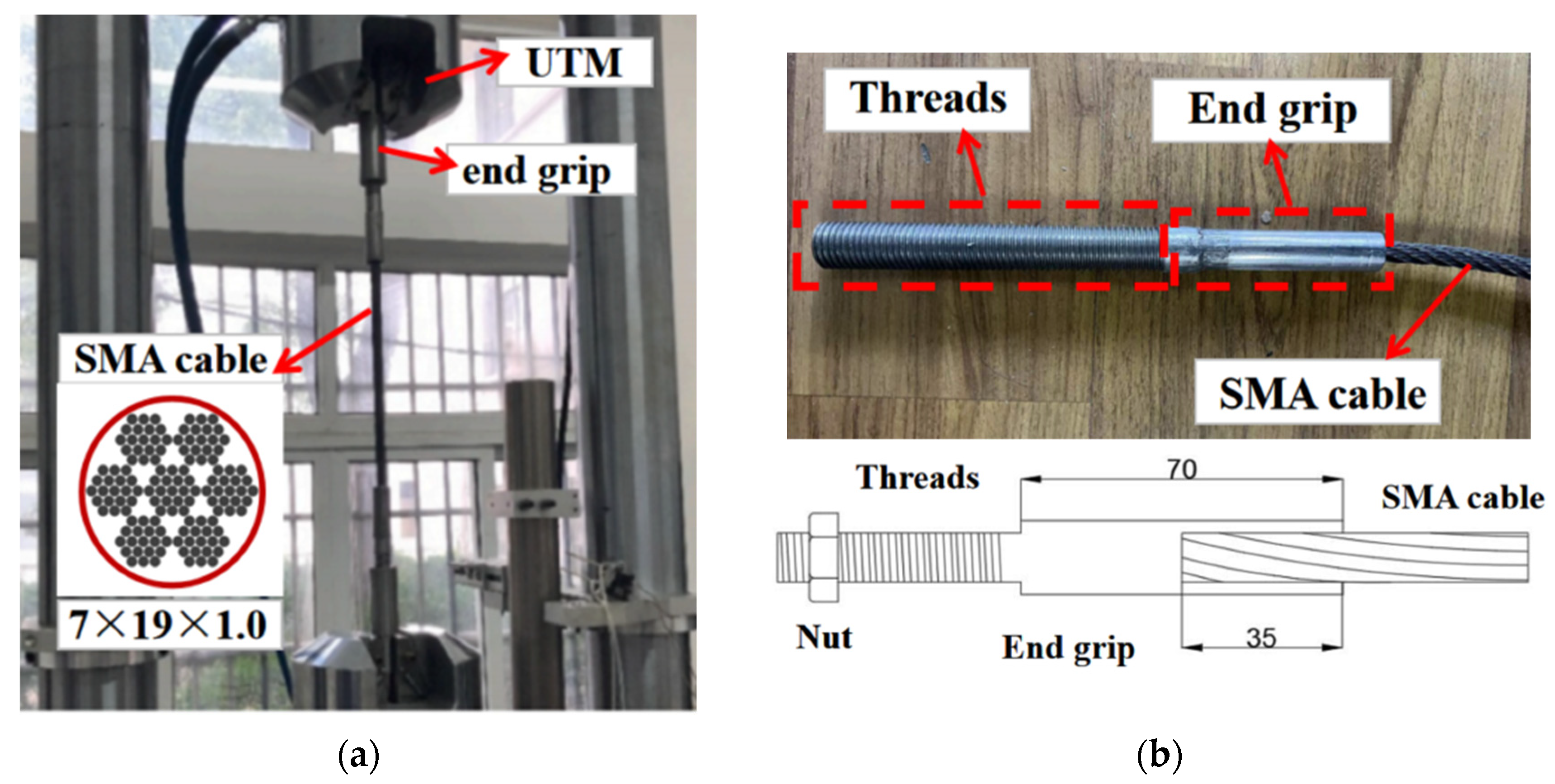
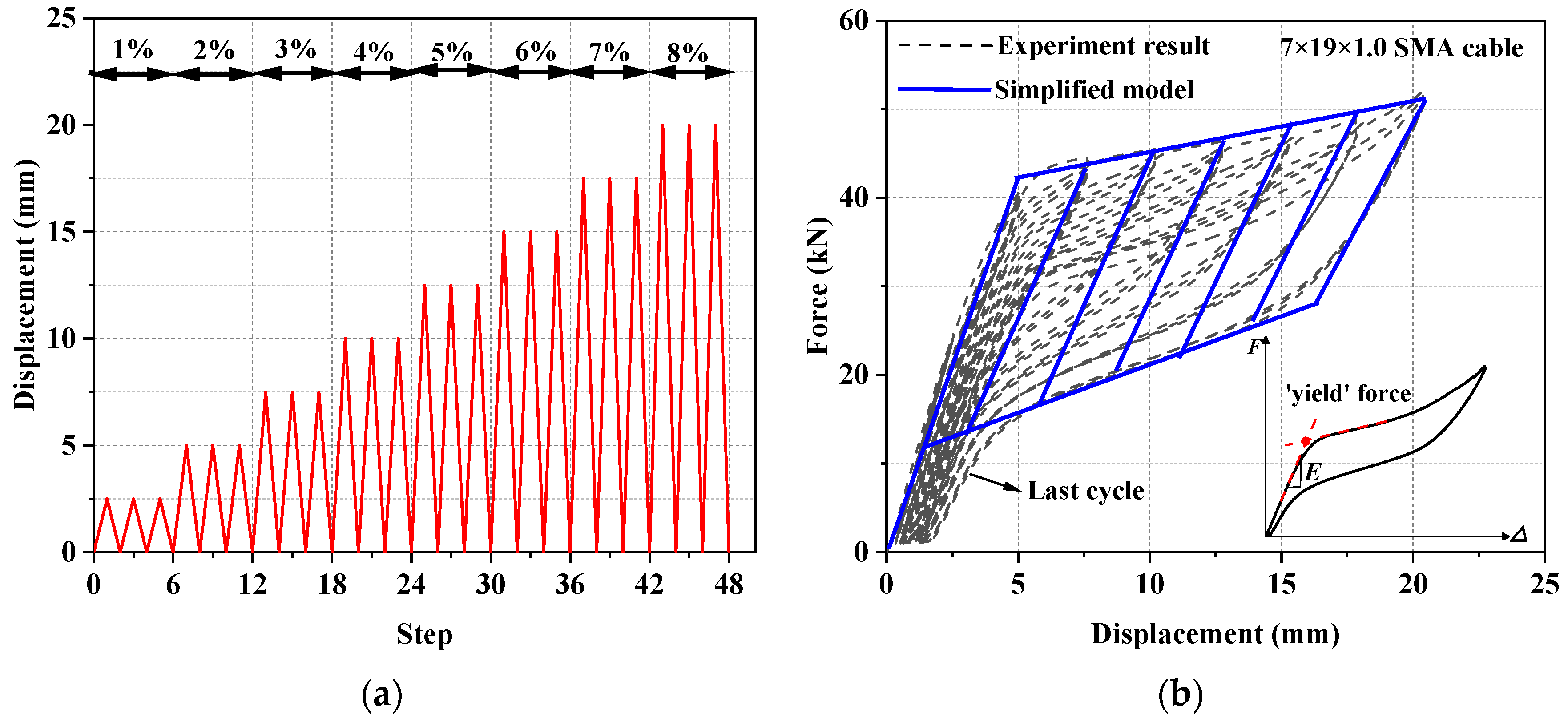


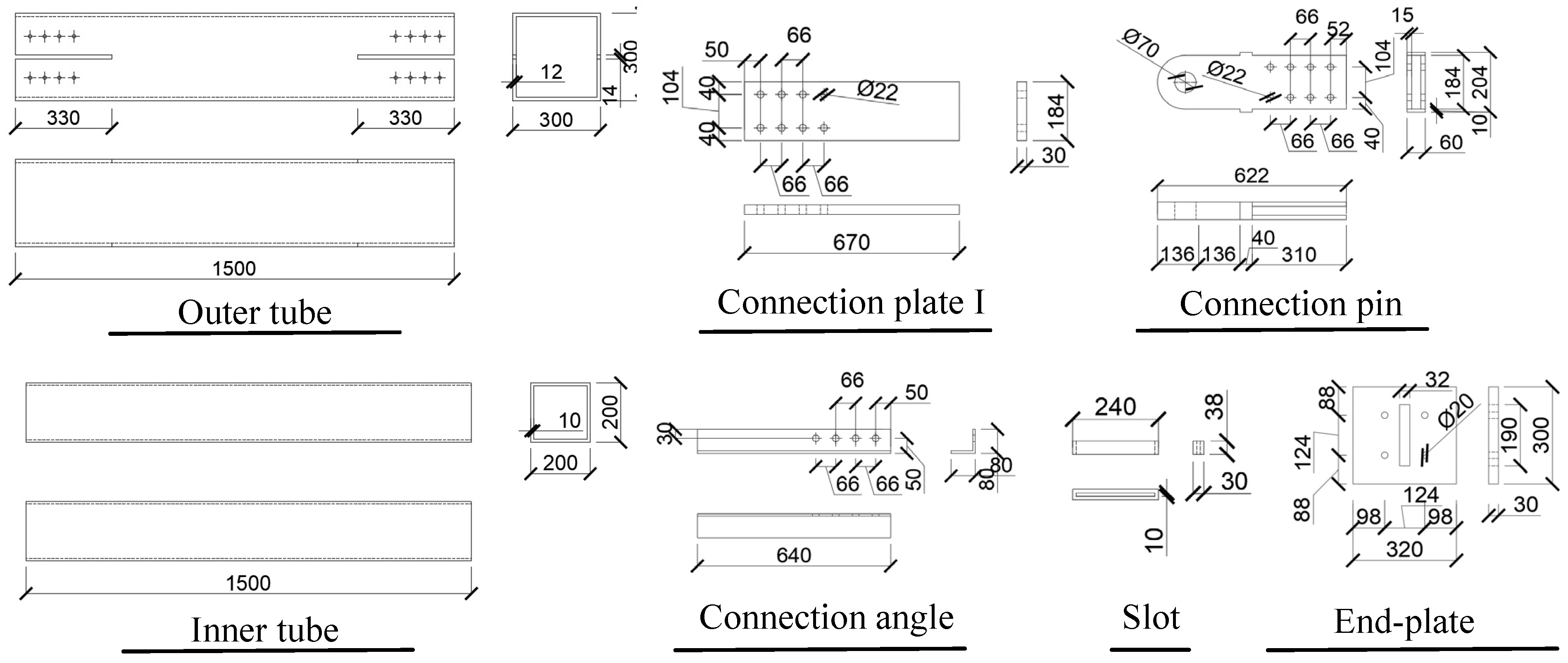


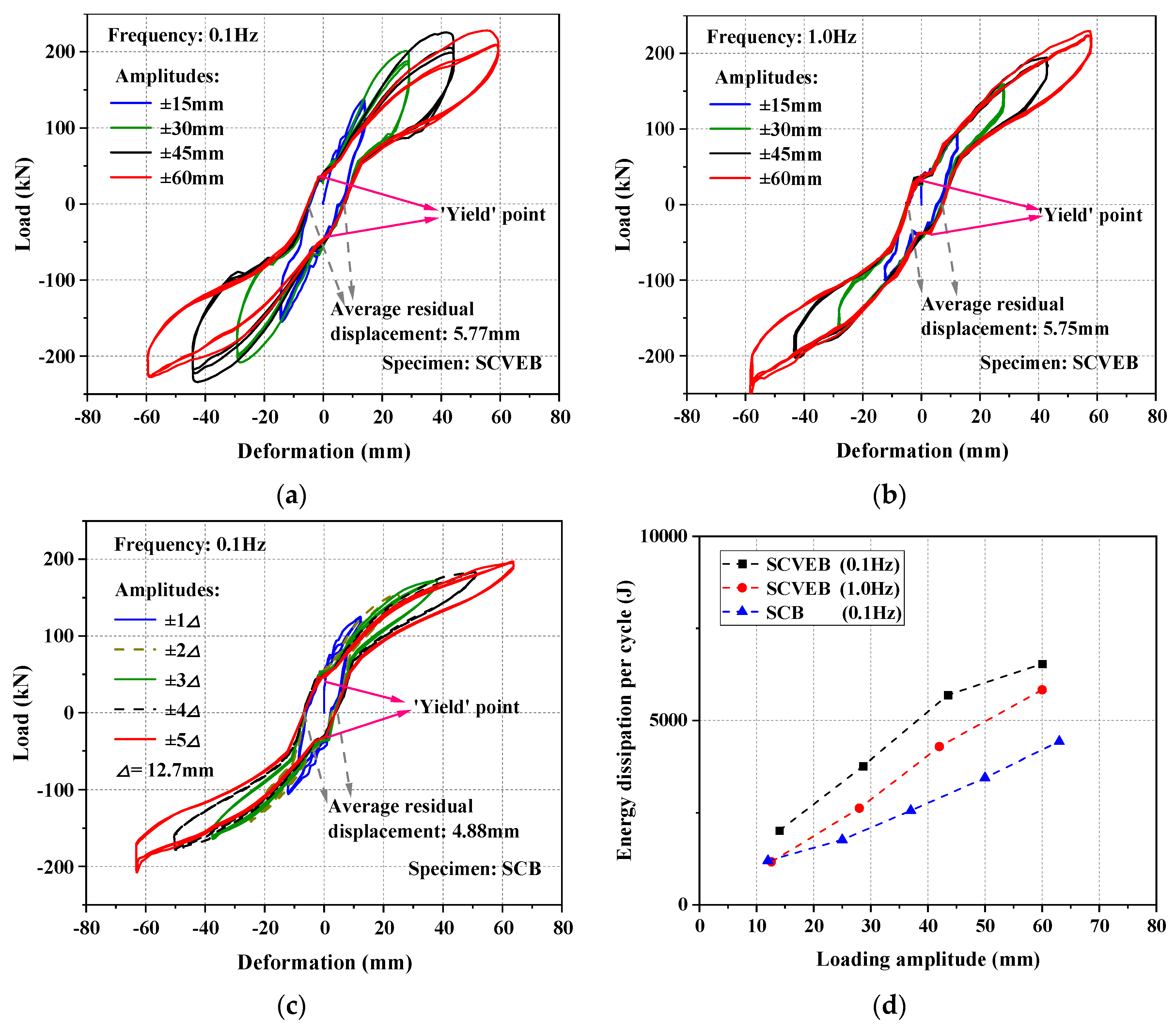
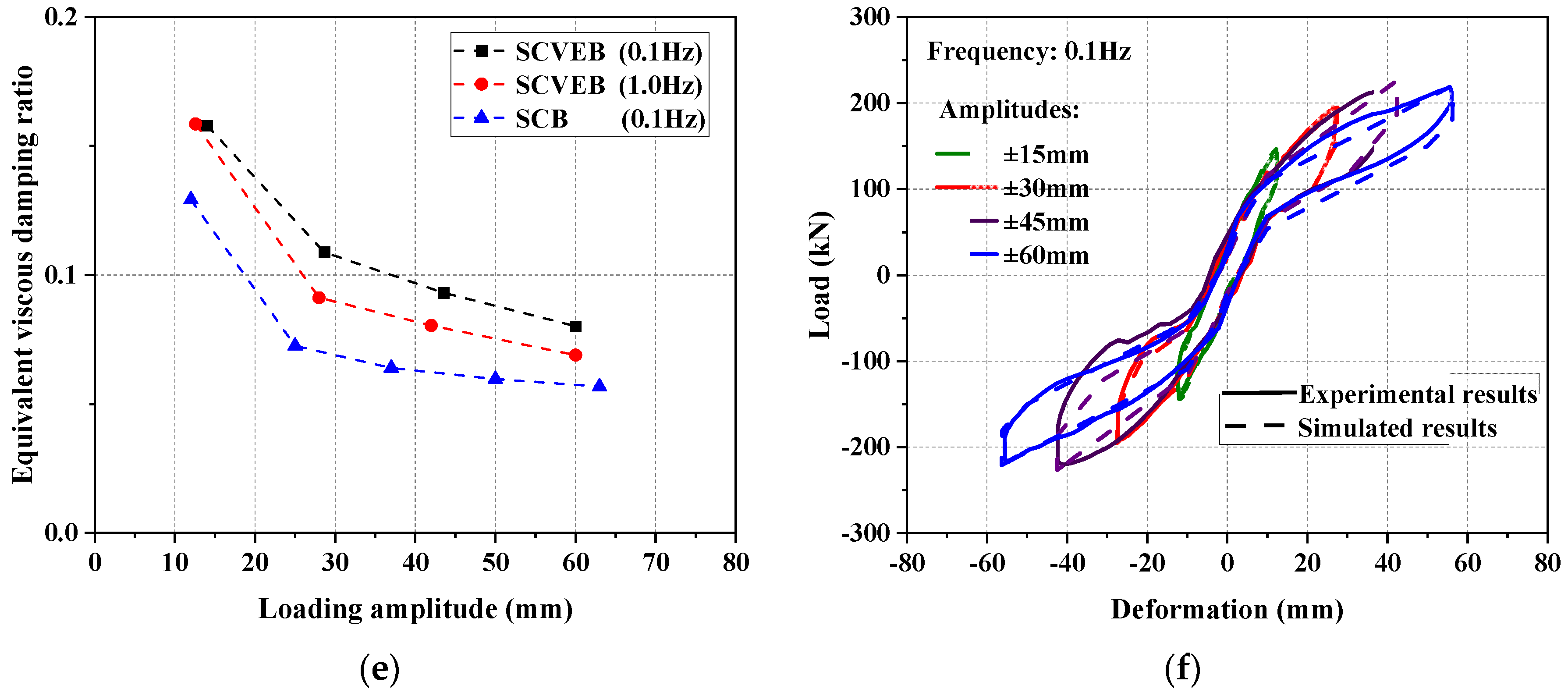

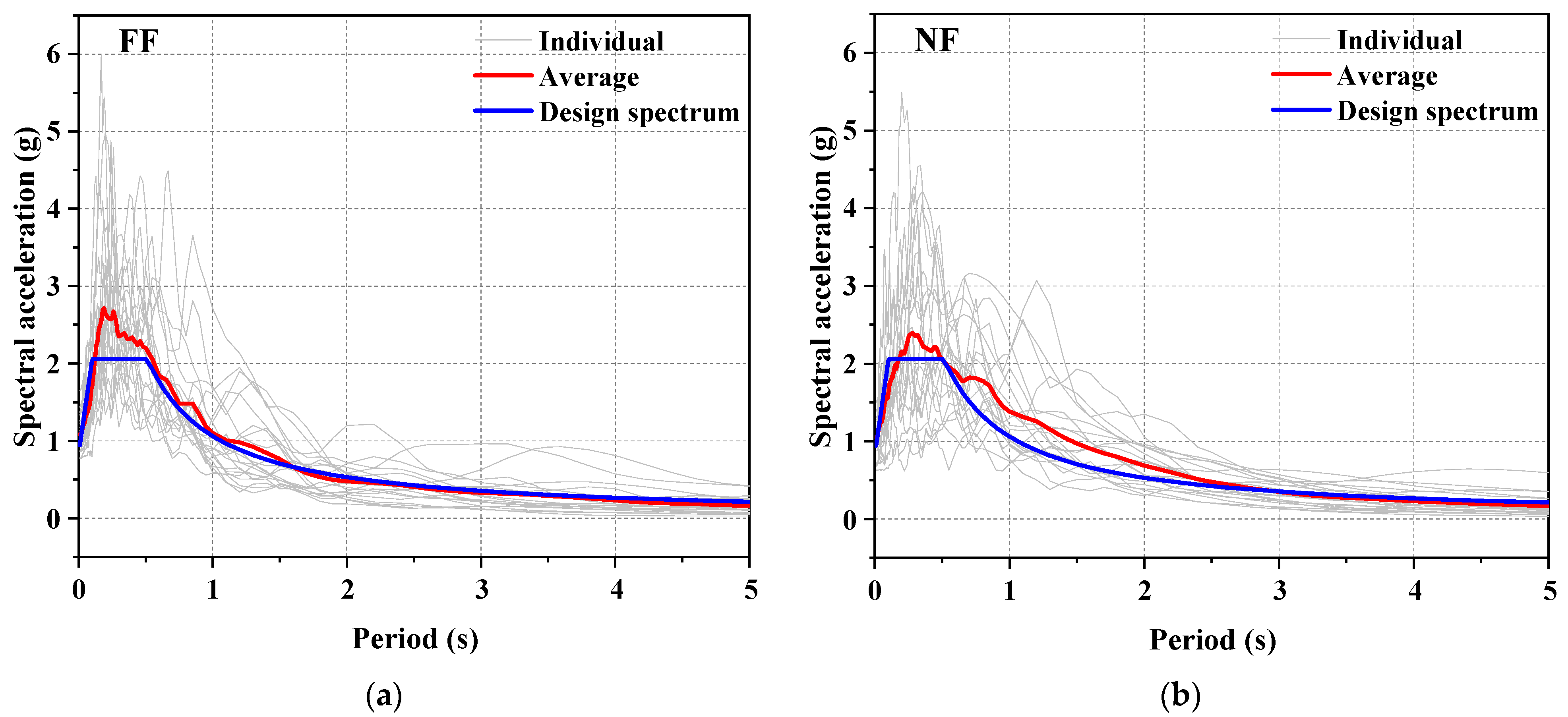

| BRBF | SCBF | SCVEBF | ||||||||
|---|---|---|---|---|---|---|---|---|---|---|
| Story | kini (kN/mm) | Fy (kN) | A (mm2) | No. | lSMA (mm) | Fp (kN) | No. | lSMA (mm) | Fp (kN) | L × W × H (mm × mm) |
| 1 | 400.4 | 2448.2 | 10,418 | 32 | 1760 | 2407 | 20 | 1760 | 1504 | 500 × 280 × 30 |
| 2 | 329.6 | 1706.3 | 7261 | 22 | 1500 | 1655 | 15 | 1500 | 1128 | 500 × 210 × 30 |
| 3 | 256.2 | 1326.1 | 5643 | 18 | 1500 | 1354 | 13 | 1500 | 978 | 500 × 180 × 30 |
| 4 | 228.9 | 1185.1 | 5043 | 16 | 1500 | 1203 | 12 | 1500 | 902 | 500 × 160 × 30 |
| 5 | 223.6 | 1157.4 | 4925 | 16 | 1500 | 1203 | 10 | 1500 | 752 | 500 × 140 × 30 |
| 6 | 185.1 | 958.1 | 4077 | 12 | 1500 | 902 | 9 | 1500 | 677 | 500 × 125 × 30 |
| 7 | 155.4 | 804.6 | 3424 | 10 | 1500 | 752 | 8 | 1500 | 602 | 250 × 210 × 30 |
| 8 | 102.0 | 528.3 | 2248 | 7 | 1500 | 526 | 4 | 1500 | 301 | 250 × 110 × 30 |
| 9 | 61.9 | 320.3 | 1363 | 4 | 1500 | 301 | 2 | 1500 | 150 | 250 × 70 × 30 |
Publisher’s Note: MDPI stays neutral with regard to jurisdictional claims in published maps and institutional affiliations. |
© 2022 by the authors. Licensee MDPI, Basel, Switzerland. This article is an open access article distributed under the terms and conditions of the Creative Commons Attribution (CC BY) license (https://creativecommons.org/licenses/by/4.0/).
Share and Cite
Zhang, Z.-X.; Ping, Y.; He, X. Self-Centering Shape Memory Alloy-Viscoelastic Hybrid Braces for Seismic Resilience. Materials 2022, 15, 2349. https://doi.org/10.3390/ma15072349
Zhang Z-X, Ping Y, He X. Self-Centering Shape Memory Alloy-Viscoelastic Hybrid Braces for Seismic Resilience. Materials. 2022; 15(7):2349. https://doi.org/10.3390/ma15072349
Chicago/Turabian StyleZhang, Zhe-Xi, Yiwei Ping, and Xiuzhang He. 2022. "Self-Centering Shape Memory Alloy-Viscoelastic Hybrid Braces for Seismic Resilience" Materials 15, no. 7: 2349. https://doi.org/10.3390/ma15072349
APA StyleZhang, Z.-X., Ping, Y., & He, X. (2022). Self-Centering Shape Memory Alloy-Viscoelastic Hybrid Braces for Seismic Resilience. Materials, 15(7), 2349. https://doi.org/10.3390/ma15072349







